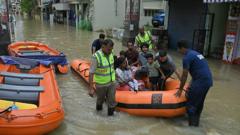With an early start in tech education and a growing ecosystem of startups, Armenia is leveraging its historical strengths in mathematics and computing while attracting global talent, especially amidst current geopolitical changes.
Armenia's Vision: A Tech Hub in the Heart of the Caucasus

Armenia's Vision: A Tech Hub in the Heart of the Caucasus
Armenia is actively cultivating its tech sector, aiming to transform itself into a regional powerhouse in innovation and technology.
Armenia is positioning itself as a burgeoning tech center in the Caucasus, with innovative programs and a focus on early tech education. In a vibrant school in Yerevan, young students like nine-year-old Slavik are learning essential programming skills, creating inventions that reflect both creativity and technical prowess. Their success stories are the result of the Armath program, launched by the Union of Advanced Technology Enterprises (UATE) in 2014, which promotes engineering education across the nation.
The UATE, representing over 200 high-tech companies, aims to establish Armenia as a tech powerhouse. With 650 Armath labs operational and 17,000 students involved, there are ambitious goals to nurture engineering talent to meet the demand from a growing tech sector, which has swelled to approximately 4,000 companies. More than $2 million in annual funding from the education ministry supports this initiative.
Despite its limitations, including being landlocked and having no natural resources, Armenia's legacy in math and computing can be traced back to the Soviet era. This historical backdrop serves as a foundation for contemporary developments, as successful startups like Picsart and Krisp underline the potential of Armenian innovation.
Helpful ties to the global Armenian diaspora, particularly in the United States, play a crucial role in sparking investment and connectivity for Armenian startups. Programs like SmartGate facilitate introductions for Armenian entrepreneurs in the competitive US market, while local ventures, including apps like Dr Yan, are reshaping industries such as healthcare. Founder Irina Ghazaryan exemplifies the entrepreneurial spirit, noting her app’s impressive growth and plans for regional expansion.
The recent influx of Russian IT professionals into Armenia, spurred by geopolitical upheaval, has further invigorated the local tech landscape. With thousands seeking refuge from instability, new skills are being integrated into Armenia’s tech workforce. While challenges remain, such as high operational costs, optimism persists among industry leaders, who foresee continued growth, especially given the recent successes of homegrown firms on international platforms.
In summary, Armenia's journey to create a vibrant tech ecosystem reflects a broader ambition to compete on a global scale, transforming historical strengths into a modern tech hub for the Caucasus.
The UATE, representing over 200 high-tech companies, aims to establish Armenia as a tech powerhouse. With 650 Armath labs operational and 17,000 students involved, there are ambitious goals to nurture engineering talent to meet the demand from a growing tech sector, which has swelled to approximately 4,000 companies. More than $2 million in annual funding from the education ministry supports this initiative.
Despite its limitations, including being landlocked and having no natural resources, Armenia's legacy in math and computing can be traced back to the Soviet era. This historical backdrop serves as a foundation for contemporary developments, as successful startups like Picsart and Krisp underline the potential of Armenian innovation.
Helpful ties to the global Armenian diaspora, particularly in the United States, play a crucial role in sparking investment and connectivity for Armenian startups. Programs like SmartGate facilitate introductions for Armenian entrepreneurs in the competitive US market, while local ventures, including apps like Dr Yan, are reshaping industries such as healthcare. Founder Irina Ghazaryan exemplifies the entrepreneurial spirit, noting her app’s impressive growth and plans for regional expansion.
The recent influx of Russian IT professionals into Armenia, spurred by geopolitical upheaval, has further invigorated the local tech landscape. With thousands seeking refuge from instability, new skills are being integrated into Armenia’s tech workforce. While challenges remain, such as high operational costs, optimism persists among industry leaders, who foresee continued growth, especially given the recent successes of homegrown firms on international platforms.
In summary, Armenia's journey to create a vibrant tech ecosystem reflects a broader ambition to compete on a global scale, transforming historical strengths into a modern tech hub for the Caucasus.

















